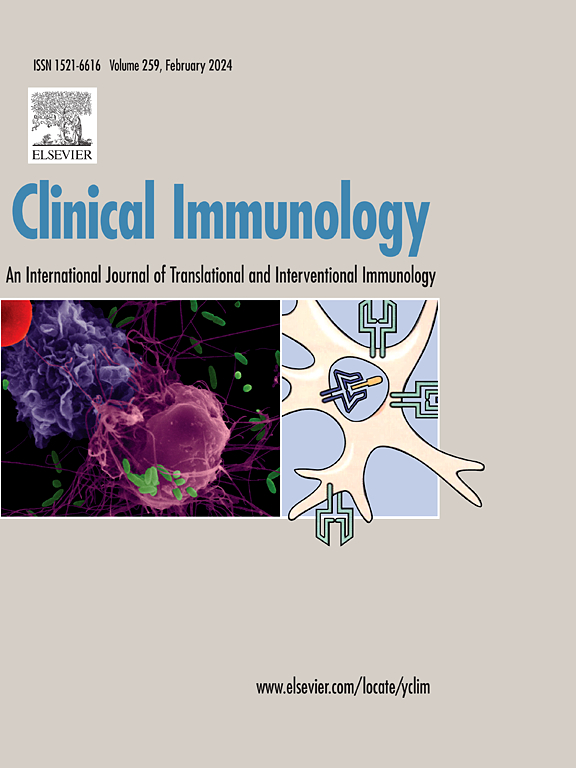抗牙龈卟啉单胞菌新肽抗体作为类风湿关节炎生物标志物的鉴定
IF 3.8
3区 医学
Q2 IMMUNOLOGY
引用次数: 0
摘要
目前类风湿关节炎(RA)的血清学标志物在早期或血清阴性疾病中缺乏敏感性。我们评估了针对牙龈卟啉单胞菌rgpa衍生肽的抗br1抗体,作为一种新的生物标志物。在训练队列中筛选的15个多肽中,BR1显示出最高的诊断潜力(AUC = 0.9553)。在一个独立的验证队列中,抗br1的AUC为0.7668,基于roc衍生的截止值,具有58.6%的敏感性和97.7%的特异性。140例RA患者中有82例(58.6%)检测到抗br1抗体,其中58例血清阴性患者中有35例(60.3%),38例早期关节炎(EA)患者中有16例(42.1%)检测到抗br1抗体,优于RF和ACPA。将抗br1与RF和ACPA联合使用,RA的诊断率从58.6%提高到83.6%,EA的诊断率从26.3%提高到55.3%。本文章由计算机程序翻译,如有差异,请以英文原文为准。
“Identification of an antibody against a novel peptide from Porphyromonas gingivalis as a biomarker for rheumatoid arthritis”
Current serological markers for rheumatoid arthritis (RA) lack sensitivity in early or seronegative disease. We evaluated anti-BR1 antibodies, targeting a Porphyromonas gingivalis RgpA-derived peptide, as a novel biomarker. From 15 peptides screened in a training cohort, BR1 showed the highest diagnostic potential (AUC = 0.9553). In an independent validation cohort, anti-BR1 demonstrated an AUC of 0.7668, with 58.6 % sensitivity and 97.0 % specificity based on a ROC-derived cutoff. Anti-BR1 antibodies were detected in 82 of 140 (58.6 %) RA cases, including 35 of 58 (60.3 %) seronegative patients, and in 16 of 38 (42.1 %) early arthritis (EA) cases, outperforming RF and ACPA. Combining anti-BR1 with RF and ACPA increased the diagnostic yield from 58.6 % to 83.6 % in RA, and from 26.3 % to 55.3 % in EA.
求助全文
通过发布文献求助,成功后即可免费获取论文全文。
去求助
来源期刊

Clinical immunology
医学-免疫学
CiteScore
12.30
自引率
1.20%
发文量
212
审稿时长
34 days
期刊介绍:
Clinical Immunology publishes original research delving into the molecular and cellular foundations of immunological diseases. Additionally, the journal includes reviews covering timely subjects in basic immunology, along with case reports and letters to the editor.
 求助内容:
求助内容: 应助结果提醒方式:
应助结果提醒方式:


